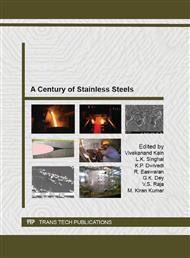[1]
Information on http: /oica. net.
Google Scholar
[2]
Juho Talonen, Effect of strain-induced α'-martensite transformation on mechanical properties of metastable austenitic stainless steels - Doctoral dissertation (2007), Department of Mechanical Engineering, Helsinki University of Technology.
Google Scholar
[3]
T. Angel, Formation of Martensite in Austenitic Stainless Steels - Effects of deformation, temperature and composition, Journal of the Iron and Steel Institute 177 (1954) 165-174.
Google Scholar
[4]
G.W. Powell, E.R. Marshall and W.A. Backofen, Strain Hardening of Austenitic Stainless Steel. Transactions of the ASM 50 (1) (1958) 478-497.
Google Scholar
[5]
G.B. Olson and M. Cohen, Martensitic Transformation as a Deformation Process, Proceedings of Earl R. Parker Symposium on Structure/Property Relationships, TMS-AIME, Warrendale, PA (1986) 367.
Google Scholar
[6]
T. Iwamoto and T. Tsuta, Computational simulation of the dependence of the austenitic grain size on the deformation behavior of TRIP steels, International Journal of Plasticity, 16 (7-8) (2000) 791-804.
DOI: 10.1016/s0749-6419(99)00079-0
Google Scholar
[7]
J.P. Bressanelli and A. Moskowitz, Effects of Strain Rate, Temperature, and Composition on Tensile Properties of Metastable Austenitic Stainless Steels, Transactions of American Society for Metals, 59 (2) (1966) 223-239.
Google Scholar
[8]
G.L. Huang, DK. Matlock and G. Krauss, Martensite formation, strain rate sensitivity, and deformation behavior of type 304 stainless steel sheet, Metallurgical Transactions A, 20 (7) (1989) 1239-1246.
DOI: 10.1007/bf02647406
Google Scholar
[9]
R. Andersson, E. Schedin, C. Magnusson, J. Ocklund and A. Persson, The Applicability of Stainless Steels for Crash Absorbing Components, SAE Technical Paper 2002-01-2020, (2002).
DOI: 10.4271/2002-01-2020
Google Scholar
[10]
K. Hariharan, G. Balachandran and M. Sathya Prasad, Application of cost-effective stainless steel for automotive components, Materials and Manufacturing Processes 24 (2009) 1442–1452.
DOI: 10.1080/10426910903179989
Google Scholar
[11]
Yingyot Aue-U-Lan, Gracious Ngaile and Taylan Altan, Optimizing tube hydroforming using process simulation and experimental verification, Journal of Materials Processing Technology 146 (2004) 137–143.
DOI: 10.1016/s0924-0136(03)00854-9
Google Scholar
[12]
Lars-Erik Lindgren, Mikael Olsson and Per Carlsson, Simulation of hydroforming of steel tube made of metastable stainless steel, International Journal of Plasticity 26 (2010) 1576 –1590.
DOI: 10.1016/j.ijplas.2010.01.012
Google Scholar
[13]
V. Tsakiris and D.V. Edmonds, Martensite and deformation twinning in austenitic steels. Materials Science and Engineering A273–275 (1999) 430–436.
DOI: 10.1016/s0921-5093(99)00322-6
Google Scholar
[14]
Filippo Placidi and Stefano Fraschetti, Potential application of stainless steel for vehicle crashworthiness structures, Proceedings of 1st International Conference of Super-High Strength Steels Rome 2-4 November, (2005).
Google Scholar
[15]
J. Bruce Emmons and Leonard J. Blessing, Ultra-light Stainless Steel Urban Bus Concept, SAE technical paper series, 2001-01-(2073).
DOI: 10.4271/2001-01-2073
Google Scholar
[16]
Bruce Emmons, System optimization of an ultralight electric transit bus, Autokinetics, April 20, (2006).
Google Scholar
[17]
B. Michel, S. Saedlou, J.M. Herbelin and P.O. Santacreu, Corrosion simulation tests on stainless steel for automotive applications, Technical Publications (2012) ArcelorMittal.
Google Scholar
[18]
Pierre-Olivier Santacreu, Laurent Faivre and Antoine Acher, On potential applications of ferritic stainless steel grades in high temperature environment, INOX 2010 Brazilian Stainless Steel conference.
DOI: 10.4271/2011-01-0194
Google Scholar


